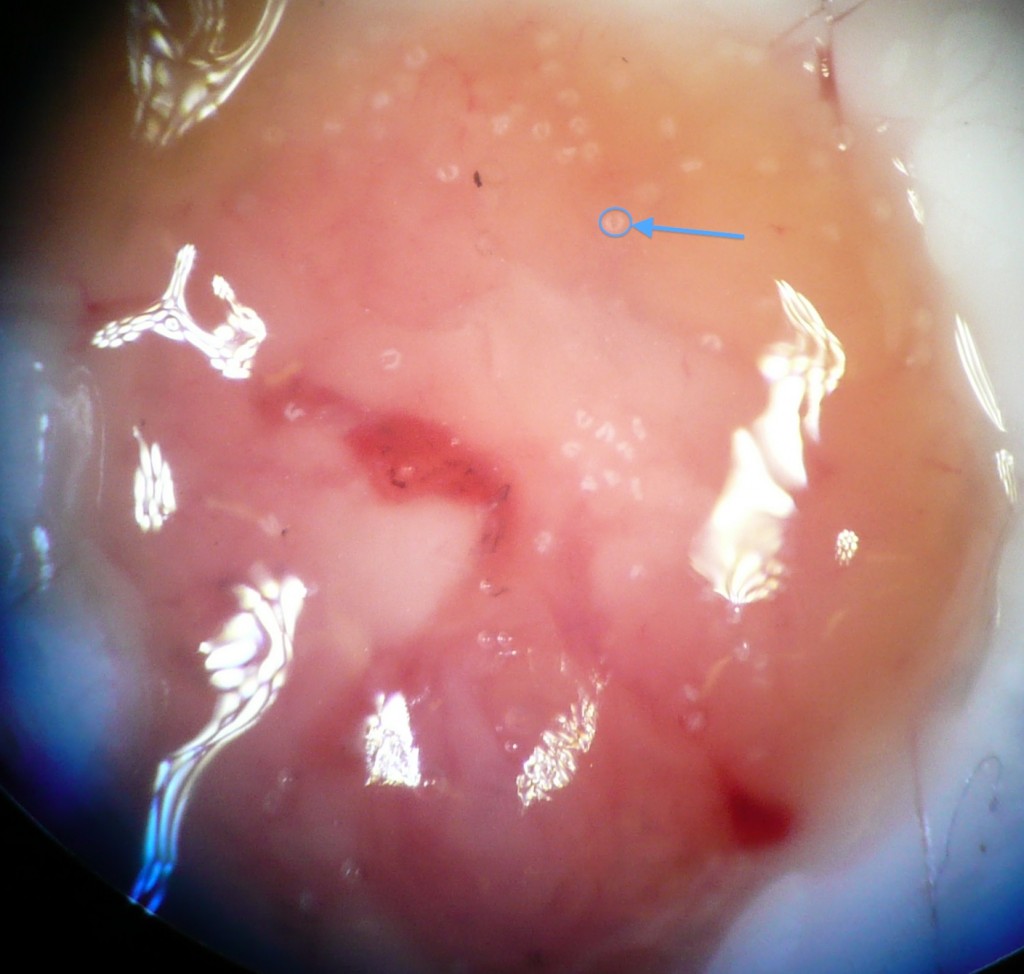Recently I’ve discussed some intense killifish ectoparasites (see here and here), but now we’re gearing up for the good stuff. If you think their ectoparasites are extreme, wait until you get a load of the trematodes infecting their liver!
Below is a California killifish liver which has been squished a bit to make it easier to see all of the trematode metacercariae it’s harboring. The arrow points to a metacercariae, which should give you an idea of what you’re looking for.
 My collaborator at the University of Alabama, Amanda Hanninen, and I dissected 39 killifish and found that they had an average of 46 of these metacercariae. The situation is worse for the males, who harbor 50% more parasites than the females (i.e., the males harbor an average of 54 while the females have an average of 36). In fact, one male had 260 metacercariae infecting its liver! This suggests that something behavioral or immunological about males and females differs which is important in determining encounter and/or infection rates with the parasites. Alternatively, female survival could be more affected by harboring these parasites, suggesting that females could have encountered the same number of parasites but consequently died in some way (e.g., predation) and therefore weren’t present in the fish sample.
My collaborator at the University of Alabama, Amanda Hanninen, and I dissected 39 killifish and found that they had an average of 46 of these metacercariae. The situation is worse for the males, who harbor 50% more parasites than the females (i.e., the males harbor an average of 54 while the females have an average of 36). In fact, one male had 260 metacercariae infecting its liver! This suggests that something behavioral or immunological about males and females differs which is important in determining encounter and/or infection rates with the parasites. Alternatively, female survival could be more affected by harboring these parasites, suggesting that females could have encountered the same number of parasites but consequently died in some way (e.g., predation) and therefore weren’t present in the fish sample.
This parasite is known as Renicola buchanani, and its definitive host is the predatory birds which consume California killifish. In the wild, California killifish are commonly infected with this parasite and Euhaplorchis californiensis, which is another trematode parasite living on the fish’s brain. Fish infected with these parasites exhibit conspicuous behaviors, including shimmying, jerking, and flashing their bright bellies, which are likely to draw the attention of predatory birds. Euhaplorchis californiensis appears to be the more potent behavioral modifier, which is perhaps not surprising as it’s taken up residence in the fish’s central command station. Renicola buchanani probably benefits from co-occuring with E. californiensis by “letting” E. californiensis do all of the behavioral modification legwork involved in getting these two parasites into their shared definitive host. They’re probably parasitic hitch-hikers!
The information in the previous paragraph comes from this paper, written by Kevin Lafferty and Kimo Morris.
More on Euhaplorchis californiensis coming soon!

HAPPY BIRTHDAY, NERD!
(I realise I’m 5 days late, but I was reading SMBC and Zach commanded me)
Hey! I like this post! 🙂
I thought you might. 😉
With that sample size (c. 20 males and females) and quite a wide spread/distribution of parasites per liver, the difference between the males and females might not be very significant and could just happen by chance (especially if there is no a priori reason to assume a difference between males and females). For example the male with 260 parasites raises the average by around 13 and accounts for most of the difference between the males and females.
[…] This post was mentioned on Twitter by Bora Zivkovic, Livio L. Livio L said: RT @BoraZ: More trouble for the killifish http://bit.ly/b4YRhH […]
[…] More trouble for the killifish […]
Kevin Lafferty does the coolest work, my wife has a “science crush” on him. I might a little bit too…